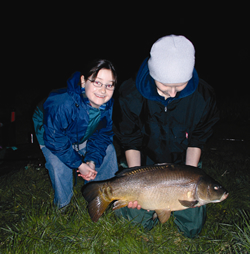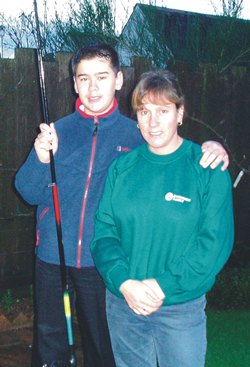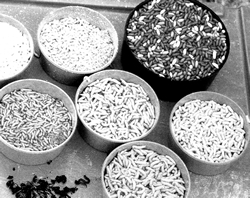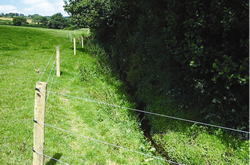My father in the 1950s wrote many serious fishing articles, one memorably for The Field entitled “Duffer with a Dryfly”. My father was overly modest, however, as he was a fine fisherman, both in temperament, cunning and dexterity. Alas, these are all characteristics I lack.
Whilst my father saw travel as a means to indulge his passion for fishing and thought nothing of punctuating a business trip to New Zealand with several (highly successful) days fishing on Lake Taupo, I always felt pressured on business travel to keep my mind on the job in hand. Father would weasel a few days free salmon fishing off the Canadian Government without any qualms, or even address stony-faced Serb soldiers in schoolboy French in order to get a permit to travel - and fish - in postwar Yugoslavia. But he sadly never had the chance to enjoy retirement and died quite young.
So when I took early retirement I settled in Devon, as far as possible from the business end of England, determined to enjoy the rural life.
One of the first local friends that I made was a retired doctor. Still fishing in his nineties, the doctor is like quicksilver over a style and has the enthusiasm of a teenager. A prodigious catcher of fish, he ties most of his own flies including a hairy monstrosity he once proudly showed me, called a ‘Woolly Bugger’.
“You must join our little club” he said, early in our acquaintance, when I carelessly admitted to the ownership of my father’s old fly rod. Since the doctor had been the founding secretary of this fishing fraternity for the previous 35 years, it was like receiving an order from Christ to join the disciples at the High Table.
I suppose I should have immediately confessed that my casting technique with a fly rod was sadly lacking, but I was too timid to admit this. After all, it was just a matter of extending a line and whirling it around one’s head like a dervish, as indeed I seemed to remember my father trying to show me on school holidays in Austria. When the fish bit, you ‘struck’ and just reeled in with a last-minute swoop of the net to complete the fight. Simple.
Anyway, to be on the safe side, on my first excursion with the doctor, I wore cap, glasses and a high collared jacket on a warm Summer’s day.
This was because I remembered my father telling the awful story of Jock Whitney, one-time US Ambassador to Britain, who inadvertently plucked out his own eye with a mis-cast trout fly. Clearly one needed protection. I would have gladly considered chain mail if it had been light and flexible enough.
Positioned at the other side of the lake, and sandwiched between the venerable doctor and another aged angler, I rapidly realised that I was casting at right angles to the wind which was blowing in steadily from the Bristol Channel. Downwind would have been a much happier option, but this wasn’t immediately available. I soon demonstrated my amateur status by snagging a bramble bush some 20 feet behind me.
Later in the morning I found that I was casting with a complete bird’s nest at the end of my line. Not literally, of course, the trees weren’t close enough, but the cast had become so entwined with the fly that the only remedy was to produce a pair of nail scissors from my creel (a trick learnt from my father) and cut my way out of trouble. Thus both line and cast were dramatically shortened. Still, that meant less of that finicky cast at the end of the line to get caught up on itself.
For a while there was almost total peace and quiet. The only sound was the whistle and ‘thhtt’ of line from my neighbours, who threw out some 30 yards of line on each long, leisurely cast. A moorhen clucked, distant sheep bleated and bright blue damsel flies fornicated elegantly in front of me.
Ah, this was the life. Moments for Wordsworthian reverie. A quick glance at the sky to reassure myself that the scudding clouds did not presage rain.
Oops, oh BUGGER IT. That really was a PATHETIC cast. How could I have about 20 foot of line out and manage to drop the fly only a couple of feet in front of me?
Oh well, pull it all in by hand . . .hope the doctor isn’t looking... Hello, .. .who’s having me on here? It seems I have snagged the weeds at my feet. No, no it can’t be. By God it is. Something silvery-gold is twisting around at the end of my line. Either I’ve caught a clockwork mouse or a live fish.
Reel in, reel in. Oops, too fast. It’s bending the rod double. What if it snaps? Let go a bit. The reel gives an angry buzz and the weight comes off the rod, but slowly, slowly I reel in again. Hey Presto, in 5 minutes (it felt like ages) it’s in my net - a glistening, thrashing 2lb rainbow trout on the end of a red Montana fly so well digested that it took almost as long again to dislodge from the back of its gullet.
“Did you catch one there?” asked my friend at lunchtime. I wondered if I detected a note of sardonic amusement at my inept bungling, or whether he was just being polite.
“Well done” he said. “Actually four is the quota, you know”, and he showed me four fine trout that he had already caught without my seeing.
But I didn’t need to catch anything else after lunch. I moved to a position of solitude where I could cast smoothly downwind and bask in reflected glory. A wimp perhaps, but the luckiest wimp with a wetfly on that water.
 There are many bitter sweet experiences in the life of an angler.
There are many bitter sweet experiences in the life of an angler.
 It was with some trepidation that I decided to return to coarse angling after a break of some 20 years. What had sparked this renewed enthusiasm was partly the fact that my son had taken up the sport following a holiday in France and was pestering for someone to take him fishing. My own return has led me to realise just how difficult it is to get back into the sport and how daunting it must be for new people wanting to give it a try.
It was with some trepidation that I decided to return to coarse angling after a break of some 20 years. What had sparked this renewed enthusiasm was partly the fact that my son had taken up the sport following a holiday in France and was pestering for someone to take him fishing. My own return has led me to realise just how difficult it is to get back into the sport and how daunting it must be for new people wanting to give it a try. Coarse fishing has spawned a huge variety of baits, both natural and 'unlikely'. Some of these, and the species you are likely to catch, are listed below.
Coarse fishing has spawned a huge variety of baits, both natural and 'unlikely'. Some of these, and the species you are likely to catch, are listed below.
 The Westcountry Rivers Trust is an environmentally charity established in 1995 to secure the preservation, protection, development and improvement of rivers, streams and watercourses in the Westcountry and to advance the education of the public in the management of water.
The Westcountry Rivers Trust is an environmentally charity established in 1995 to secure the preservation, protection, development and improvement of rivers, streams and watercourses in the Westcountry and to advance the education of the public in the management of water. These lofty undertakings may not, at first sight, seem relevant to the Westcountry but the causes of these problems are often found far away and it is part of the Trusts ethos to tackle problems at their source rather than trying to manage the symptoms.
These lofty undertakings may not, at first sight, seem relevant to the Westcountry but the causes of these problems are often found far away and it is part of the Trusts ethos to tackle problems at their source rather than trying to manage the symptoms. Salmon fishing in the westcountry is like no other place on earth. Many river valleys that have evolved over millions of years descend from the highest of Tors across the moors toward the Atlantic and the English Channel, each cutting deep scars through the hidden countryside and providing some of the most rugged yet the most enchanting fishing one can imagine. Others flow unhurriedly through lowland farmland that by their nature produce a much richer flora and fauna than can be found anywhere in England.
Salmon fishing in the westcountry is like no other place on earth. Many river valleys that have evolved over millions of years descend from the highest of Tors across the moors toward the Atlantic and the English Channel, each cutting deep scars through the hidden countryside and providing some of the most rugged yet the most enchanting fishing one can imagine. Others flow unhurriedly through lowland farmland that by their nature produce a much richer flora and fauna than can be found anywhere in England.